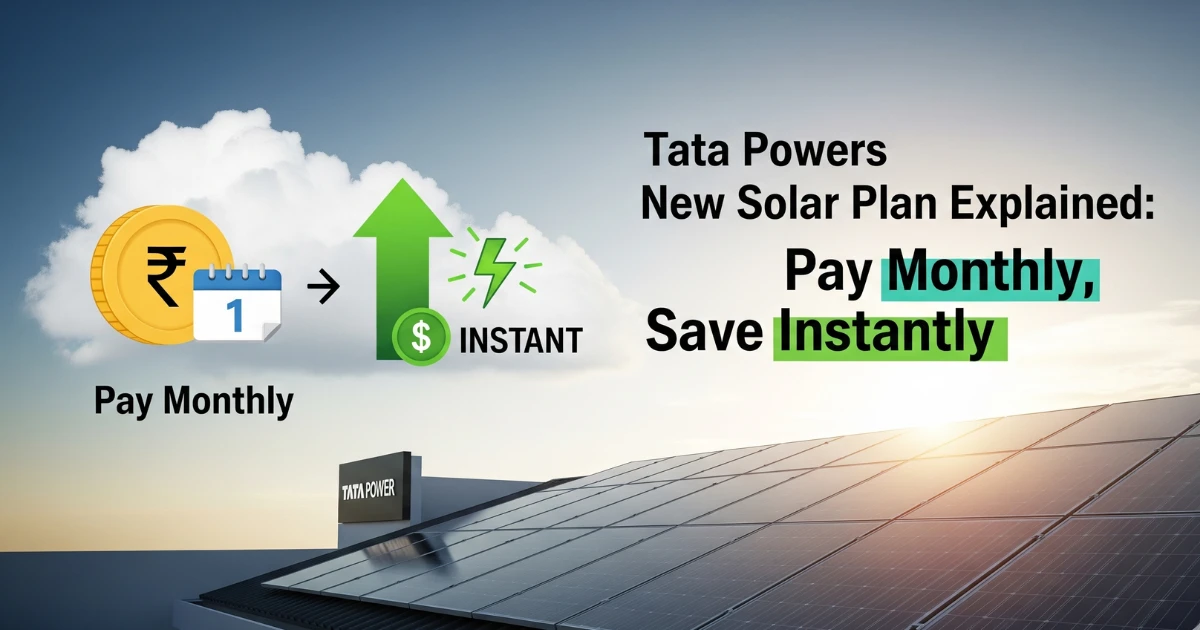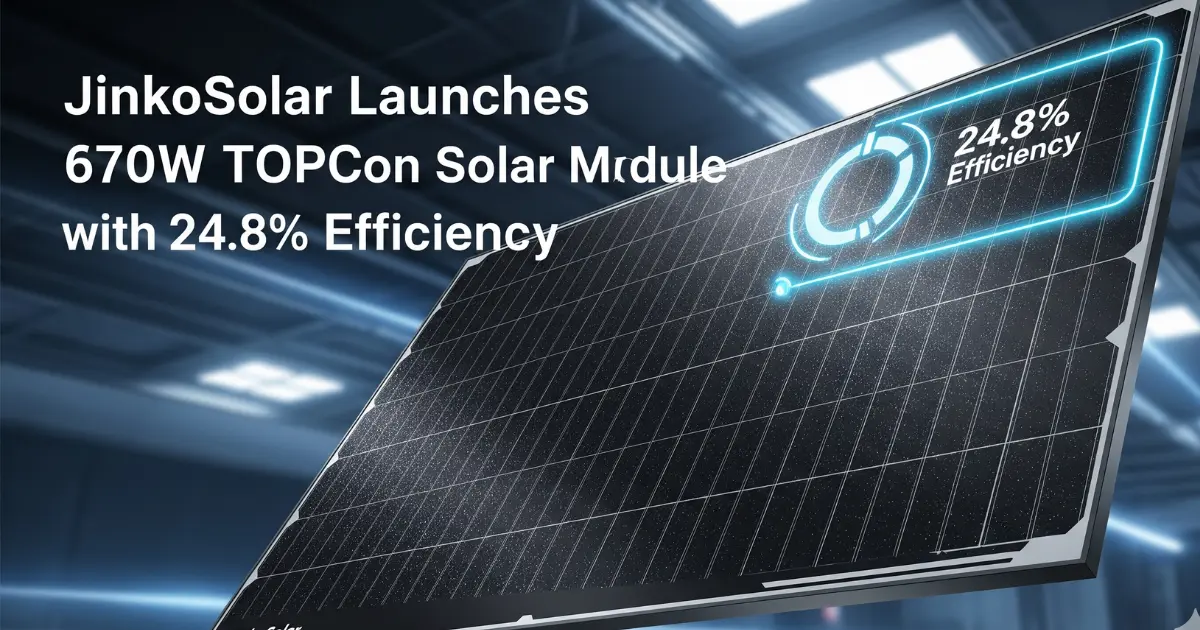Tata Powers New Solar Plan: The Indian solar market is evolving rapidly, and Tata Power has just introduced something truly game-changing ‘Pay-As-You-Go’ solar for households. This innovative model allows families to install solar systems without paying a huge upfront cost. Instead, they pay in small, manageable installments, much like a prepaid mobile plan or an EMI-based subscription.
This approach is set to make solar adoption easier for middle-class families and small businesses who previously found the upfront investment too high. In this article, we’ll break down how the Tata Power pay-as-you-go solar works, its pricing structure, real-life experiences from early adopters, and the potential ROI.
What Is Tata Power’s ‘Pay-As-You-Go’ Solar Model?
Traditionally, installing a 3kW–5kW solar system in India costs between ₹1.5 lakh to ₹3 lakh upfront, even with subsidies. This is a major financial hurdle for many households.
Tata Power’s new pay-as-you-go model changes this:
- No heavy upfront payment
- Customers pay a monthly subscription fee (₹1,500–₹3,500 depending on system size)
- The solar panels, inverter, and batteries are installed and maintained by Tata Power
- Customers enjoy reduced electricity bills while paying off the system gradually
- After the tenure ends, ownership can transfer to the household at little or no additional cost
In short, it’s solar energy on EMI without loans or paperwork.
Real-Life Case Study: Sharma Family in Pune
The Sharma family, a middle-class household in Pune, signed up for a 3kW pay-as-you-go solar system.
- Monthly fee: ₹2,100
- Electricity bill savings: ₹1,600–₹1,800/month
- Net outflow: As low as ₹300–₹500/month compared to their earlier bills
- After 7 years: They will own the system outright, and their electricity costs will drop by 60–70%.
Mr. Sharma says:
“Earlier, we couldn’t afford ₹2 lakh for solar. With this model, we are already saving money from the first month. Plus, Tata Power takes care of maintenance, so it’s stress-free.”
ROI and Long-Term Benefits of Tata Powers New Solar Plan
One of the biggest questions with new financing models is does it actually save money? Let’s break it down.
Example: 5kW Pay-As-You-Go Solar
- Traditional upfront cost: ₹2.5 lakh (after subsidy)
- Pay-as-you-go model: ₹3,200/month for 7 years = ~₹2.7 lakh total
- Savings on electricity: ₹3,500/month average = ₹2.9 lakh saved in 7 years
- Net benefit: After ownership, lifetime savings of ₹8–10 lakh over 20 years
So, even though you pay slightly more in total, you avoid the upfront burden, and the savings are immediate.
How This Helps India’s Solar Mission
India has set a target of 500 GW of renewable energy by 2030, and household adoption is key. However, upfront cost remains the biggest roadblock. Tata Power’s subscription model could significantly accelerate adoption by middle-class families.
This model is also ideal for:
- Tenants who don’t want to make a huge investment
- Small businesses running on rented properties
- Rural households looking for a reliable power source without heavy loans
Subsidy & Government Support

Currently, the PM Surya Ghar: Muft Bijli Yojana (2025) offers up to 40% subsidy for residential rooftop solar. The question is how does this work with Tata Power’s model?
- If Tata Power owns the system during the subscription, the subsidy is claimed by them.
- If you choose to buy out the system later, you may still be eligible for government incentives, depending on state policies.
- Some states like Gujarat, Rajasthan, and Maharashtra are exploring additional incentives to make subscription solar even cheaper.
This synergy of subsidy + pay-as-you-go could make solar almost as cheap as paying a regular electricity bill.
Real-Life Experience: Small Business in Jaipur
Mr. Jain runs a small printing shop in Jaipur. His monthly electricity bill was around ₹9,000. With a 5kW Tata Power subscription system, he now pays:
- Monthly solar fee: ₹3,200
- New electricity bill: ₹3,000–₹3,500
- Total energy expense: ~₹6,500 (savings of ₹2,500 per month)
“I didn’t want to lock ₹2.5 lakh into solar. With this plan, I save money right away, and after 7 years, I’ll practically get free electricity for life.”
Challenges & Considerations
While this model is promising, there are a few points to consider:
- Long-term contract: Customers need to stay committed for 6–8 years
- Ownership clarity: Make sure the buyout clause is transparent
- Subsidy eligibility: Check if you can benefit directly or if it goes to Tata Power
- Maintenance: Usually included, but verify in the contract
FAQs on Tata Powers New Solar Plan
How is this different from a solar loan?
With loans, the bank owns the liability, and you still need to pay upfront for installation. Here, Tata Power installs and maintains the system directly, and you just pay a fixed subscription fee.
Do I save money from the first month?
Yes, most households will see savings in their electricity bill that nearly offset the subscription cost.
What happens after the subscription ends?
Ownership usually transfers to you, and your solar system provides nearly free power for another 15+ years.
Can I still apply for government solar subsidies?
It depends on the ownership model. If Tata Power retains ownership during subscription, they may claim the subsidy. You should clarify at the time of agreement.
Is maintenance included in the subscription fee?
Yes, Tata Power usually includes operation and maintenance for the entire duration.
Conclusion
Tata Power’s Pay-As-You-Go Solar is set to make renewable energy accessible to millions of Indian households. By eliminating the upfront cost barrier and offering immediate savings, this model could accelerate India’s journey towards clean energy while making household budgets lighter.
For families and small businesses looking for a risk-free, affordable entry into solar, this could be the future.

